Application of Pattern Search and Genetic Algorithms to Optimize HDPE Pipe Joint Profiles and Strength in the Butt Fusion Welding Process
Abstract
:1. Introduction
2. Materials and Methods
3. Results and Discussion
3.1. Regression Analysis and ANOVA
3.2. Artificial Neural Network (ANN)
3.3. Genetic Algorithm Optimization
3.4. Pattern Search Optimization
4. Conclusions
- The heater plate temperature is most significant for the welding joint profile, while the welding pressure is most significant for the joint’s tensile strength.
- The results of the trained ANN model were more closely related to the experimental results than those of the regression analysis model based on ANOVA.
- Within certain limits, the combined increase in heater plate temperature and welding pressure leads to a significant increase in tensile strength and weld profiles for both upper and lower surfaces.
- For HDPE pipe joining, both pattern search and genetic algorithms can be considered suitable approaches for optimizing butt fusion welding parameters, with pattern search having a relative preference.
Author Contributions
Funding
Data Availability Statement
Conflicts of Interest
References
- Albertsson, A.C. Long-Term Properties of Polyolefins: Preface; Springer Science & Business Media: Berlin, Germany, 2004. [Google Scholar]
- Khajouei, M.; Khamani, S.; Adavi, K. Hybrid pipes for high performance and reliability. In Polymer Composite Systems in Pipeline Repair: Design, Manufacture, Application, and Environmental Impacts; Gulf Professional Publishing: Houston, TX, USA, 2023. [Google Scholar] [CrossRef]
- Ren, Y.; Sun, X.; Chen, L.; Li, Y.; Sun, M.; Duan, X.; Liang, W. Structures and impact strength variation of chemically crosslinked high-density polyethylene: Effect of crosslinking density. RSC Adv. 2021, 11, 6791–6797. [Google Scholar] [CrossRef] [PubMed]
- Tariq, F.; Naz, N.; Khan, M.A.; Baloch, R.A. Failure analysis of high density polyethylene butt weld joint. J. Fail. Anal. Prev. 2012, 12, 168–180. [Google Scholar] [CrossRef]
- Bai, C.; Lin, R.; Lai, H.S. Investigation of Creep Behavior of HDPE Pipe Butt Fusion Welded Joints Using a Stepped Isostress Method. Polymers 2024, 16, 1803. [Google Scholar] [CrossRef] [PubMed]
- Riahi, M.; Kooshayan, K.; Ghanati, M.F. Analysis of effect of pressure and heat on mechanical characteristics of butt fusion welding of polyethylene pipes. Polym.-Plast. Technol. Eng. 2011, 50, 907–915. [Google Scholar] [CrossRef]
- Lee, B.Y.; Kim, J.S.; Lee, S.Y.; Kim, Y.K. Butt-welding technology for double walled Polyethylene pipe. Mater. Des. 2012, 35, 626–632. [Google Scholar] [CrossRef]
- Tao, Y.; Guo, W.; Shi, Y.; Miao, C.; Tang, P. Study on Molten Zone of Butt Fusion Welding Process With Phased Array Ultrasonic Technology for Polyethylene Pipe. In Proceedings of the ASME 2023 Pressure Vessels & Piping Conference, Atlanta, GA, USA, 16–21 July 2023. V001T01A011. [Google Scholar] [CrossRef]
- Wang, Z.; Xu, L.; You, Q.; Peng, Y.; Zhang, Q. Design of an Intelligent Butt-Fusing Welding Machine for HDPE Pipes. In Proceedings of the ASME 2022 Pressure Vessels & Piping Conference, Volume 1: Codes and Standards, Las Vegas, NV, USA, 17–22 July 2022. V001T01A005. [Google Scholar] [CrossRef]
- Shapheek, M.; Shrivastava, N. Optimization of cooling time for polyethylene fusion joints. Mater. Today Proc. 2019, 28, 1267–1272. [Google Scholar] [CrossRef]
- Bucknall, C.B.; Drinkwater, I.C.; Smith, G.R. Hot plate welding of plastics: Factors affecting weld strength. Polym. Eng. Sci. 1980, 20, 432–440. [Google Scholar] [CrossRef]
- Pathak, S.; Pradhan, S.K. Experimentation and optimization of HDPE pipe electro fusion and butt fusion welding processes. Mater. Today Proc. 2019, 27, 2925–2929. [Google Scholar] [CrossRef]
- Shaheer, M. Effects of Welding Parameters on the Integrity and Structure of Hdpe Pipe Butt Fusion Welds. Ph.D. Thesis, Brunel University London, London, UK, 2017. [Google Scholar]
- Lai, H.S.; Tun, N.N.; Yoon, K.B.; Kil, S.H. Effects of defects on failure of butt fusion welded polyethylene pipe. Int. J. Press. Vessel. Pip. 2016, 139–140. [Google Scholar] [CrossRef]
- Faraz, A.; Zai, B.A.; Nisar, S.; Mansoor, A.; Ali, R. Measurement of structural performance of fusion weld with change of welding parameters in high-density polyethylene. J. Test. Eval. 2021, 49, 4364–4377. [Google Scholar] [CrossRef]
- Wang, Z.; Wang, B.; Xiang, A.; Jiao, D.; Yu, F.; Zhang, Q.; Zhao, X. Comparative study on the performance of butt fusion-welding processes for nuclear safety class large-diameter thick-walled PE pipes. Nucl. Eng. Technol. 2024, 139–140, 117–122. [Google Scholar] [CrossRef]
- Alkaki, S.S.; Kaman, M.O. Mechanical properties of electro and butt fusion welded high-density polyethylene pipes. Mater. Test. 2019, 61, 337–343. [Google Scholar] [CrossRef]
- Xingmin, Z.; Zhao, J.; Yan, J. Study on Constitutive Model for Butt Fusion Welded Joint of High density Polyethylene Pipe. China Plast. 2021, 35, 65–71. [Google Scholar] [CrossRef]
- Wan, Z.; Meng, D.; Zhao, Y.; Zhang, D.; Wang, Q.; Shan, J.; Song, J.; Wang, G.; Wu, A. Improvement on the tensile properties of 2219-T8 aluminum alloy TIG welding joint with weld geometry optimization. J. Manuf. Process. 2021, 67, 275–285. [Google Scholar] [CrossRef]
- Jassim, R.J.; Lieth, H.M.; Al-Sabur, R.; Alsahlani, A. Influence of welding parameters on optimization of the tensile strength and peak temperature in AISI 1020 alloy joints welded by SAW. In AIP Conference Proceedings; AIP Publishing: College Park, MD, USA, 2022; p. 020042. [Google Scholar] [CrossRef]
- Unt, A.; Salminen, A. Effect of welding parameters and the heat input on weld bead profile of laser welded T-joint in structural steel. J. Laser Appl. 2015, 27, S29002. [Google Scholar] [CrossRef]
- Riofrío, P.G.; Ferreira, J.A.; Capela, C.A. Imperfections and modelling of the weld bead profile of laser butt joints in hsla steel thin plate. Metals 2021, 11, 151. [Google Scholar] [CrossRef]
- Khalaf, H.I.; Al-Sabur, R.; Demiral, M.; Tomków, J.; Łabanowski, J.; Abdullah, M.E.; Aghajani Derazkola, H. The Effects of Pin Profile on HDPE Thermomechanical Phenomena during FSW. Polymers 2022, 14, 4632. [Google Scholar] [CrossRef]
- Zhao, H.; Shen, Z.; Booth, M.; Wen, J.; Fu, L.; Gerlich, A.P. Calculation of welding tool pin width for friction stir welding of thin overlapping sheets. Int. J. Adv. Manuf. Technol. 2018, 98, 1721–1731. [Google Scholar] [CrossRef]
- ASTM D 3035: 2008; Standard Specification for Polyethylene (PE) Plastic Pipe (DR-PR) Based on Controlled Outside Diameter. ASMT: West Conshohocken, PA, USA, 2008.
- ASTM D638; Standard Test Method for Tensile Properties of Plastics. Book of ASTM Standards. ASMT: West Conshohocken, PA, USA, 2022.
- Belaziz, A.; Mohamed, M. Experimental Study of the Weld Bead Zones of a High-Density Polyethylene Pipe (HDPE). J. Fail. Anal. Prev. 2018, 18, 667–676. [Google Scholar] [CrossRef]
- Djebli, A.; Aid, A.; Bendouba, M.; Talha, A.; Benseddiq, N.; Benguediab, M.; Zengah, S. Uniaxial Fatigue of HDPE-100 Pipe. Experimental Analysis. Eng. Technol. Appl. Sci. Res. 2014, 4, 600–604. [Google Scholar] [CrossRef]
- Velarde, G.; Binroth, C. Regression analysis: A good practice for parameter exploration and optimisation in laser welding process. Weld. Cut. 2011, 10, 322–328. [Google Scholar]
- Chikh, A.; Serier, M.; Al-Sabur, R.; Siddiquee, A.N.; Gangil, N. Thermal Modeling of Tool-Work Interface during Friction Stir Welding Process. Russ. J. Non-Ferr. Met. 2022, 63, 690–700. [Google Scholar] [CrossRef]
- Chicco, D.; Warrens, M.J.; Jurman, G. The coefficient of determination R-squared is more informative than SMAPE, MAE, MAPE, MSE and RMSE in regression analysis evaluation. PeerJ Comput. Sci. 2021, 7, e623. [Google Scholar] [CrossRef] [PubMed]
- Ahmad, M.A.; Sheikh, A.K.; Nazir, K. Design of experiment based statistical approaches to optimize submerged arc welding process parameters. ISA Trans. 2019, 94, 307–315. [Google Scholar] [CrossRef] [PubMed]
- Al-Sabur, R. Tensile strength prediction of aluminium alloys welded by FSW using response surface methodology—Comparative review. Mater. Today Proc. 2021, 45, 4504–4510. [Google Scholar] [CrossRef]
- Zhao, D.; Wang, Y.; Liang, D.; Ivanov, M. Performances of regression model and artificial neural network in monitoring welding quality based on power signal. J. Mater. Res. Technol. 2020, 9, 1231–1240. [Google Scholar] [CrossRef]
- Al-Sabur, R.; Slobodyan, M.; Chhalotre, S.; Verma, M. Contact resistance prediction of zirconium joints welded by small scale resistance spot welding using ANN and RSM models. Mater. Today Proc. 2021, 47, 5907–5911. [Google Scholar] [CrossRef]
- Kumar, R.; Aggarwal, R.K.; Sharma, J.D. Comparison of regression and artificial neural network models for estimation of global solar radiations. Renew. Sustain. Energy Rev. 2015, 52, 1294–1299. [Google Scholar] [CrossRef]
- Faraz, A.; Nisar, S.; Khan, M.A. Effect of welding parameters on the structural performance of fusion welded extruded and injection molded HDPE joints. J. Space Technol. 2014, 1, 114–119. [Google Scholar]
- Dai, H.; Peng, J. The effects of welded joint characteristics on its properties in HDPE thermal fusion welding. Mod. Phys. Lett. B 2017, 31, 1750185. [Google Scholar] [CrossRef]
- Brown, E.C.; Sumichrast, R.T. Evaluating performance advantages of grouping genetic algorithms. Eng. Appl. Artif. Intell. 2005, 18, 1–12. [Google Scholar] [CrossRef]
- Ahire, P.G.; Patil, U.S.; Kadam, M.S. Genetic Algorithm Based Optimization of the Process Parameters for Manual Metal Arc Welding of Dissimilar Metal Joint. Procedia Manuf. 2018, 20, 106–112. [Google Scholar] [CrossRef]
- Kang, J.; Chen, X.; Shao, Z. Optimization of High-Density Polyethylene Process Based on Molecular Weight Distribution and Chemical Composition Distribution under Uncertainty. In Computer Aided Chemical Engineering; Elsevier: Amsterdam, The Netherlands, 2015; Volume 37, pp. 881–886. [Google Scholar] [CrossRef]
- Alzantot, M.; Zhang, H.; Sharma, Y.; Hsieh, C.J.; Chakraborty, S.; Srivastava, M.B. GenatTack: Practical black-box attacks with gradient-free optimization. In Proceedings of the GECCO 2019—Proceedings of the 2019 Genetic and Evolutionary Computation Conference, Prague, Czech Republic, 13–17 July 2019. [Google Scholar] [CrossRef]
- Wang, S.; Da, X.; Li, M.; Han, T. Adaptive backtracking search optimization algorithm with pattern search for numerical optimization. J. Syst. Eng. Electron. 2016, 27, 395–406. [Google Scholar] [CrossRef]
- Prakash, C.; Singh, S.; Singh, M.; Gupta, M.K.; Mia, M.; Dhanda, A. Multi-objective parametric appraisal of pulsed current gas tungsten arc welding process by using hybrid optimization algorithms. Int. J. Adv. Manuf. Technol. 2019, 101, 1107–1123. [Google Scholar] [CrossRef]
- Simoncini, M.; Costa, A.; Fichera, S.; Forcellese, A. Experimental analysis and optimization to maximize ultimate tensile strength and ultimate elongation of friction stir welded aa6082 aluminum alloy. Metals 2021, 11, 69. [Google Scholar] [CrossRef]
- Guo, Z.; Jiang, H.; He, L.; Lei, Z.; Bai, R. CNN-empowered identification of heat source parameters from the cross-section profile of laser-welded zone. Int. J. Adv. Manuf. Technol. 2024, 130, 5441–5455. [Google Scholar] [CrossRef]


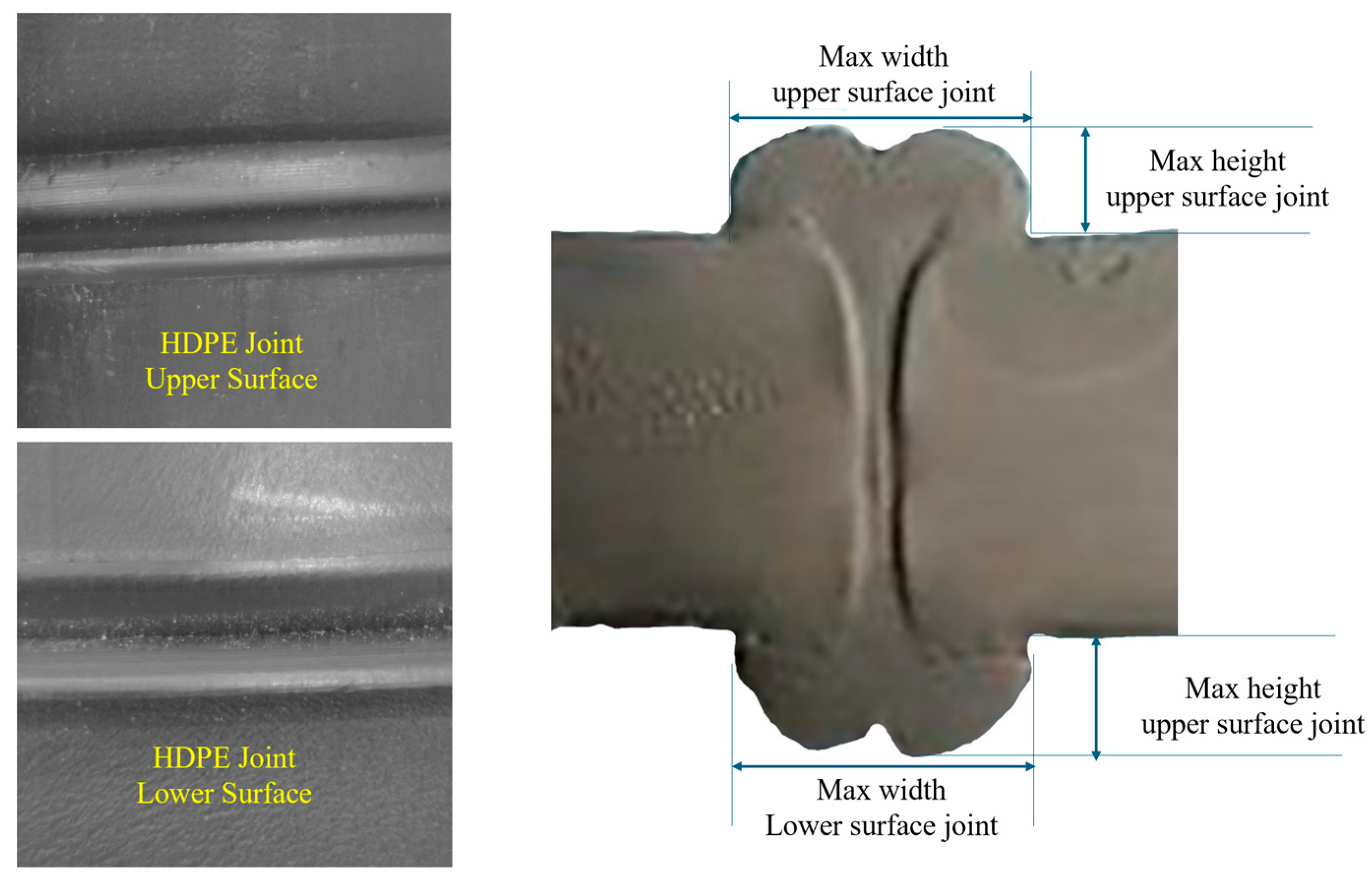

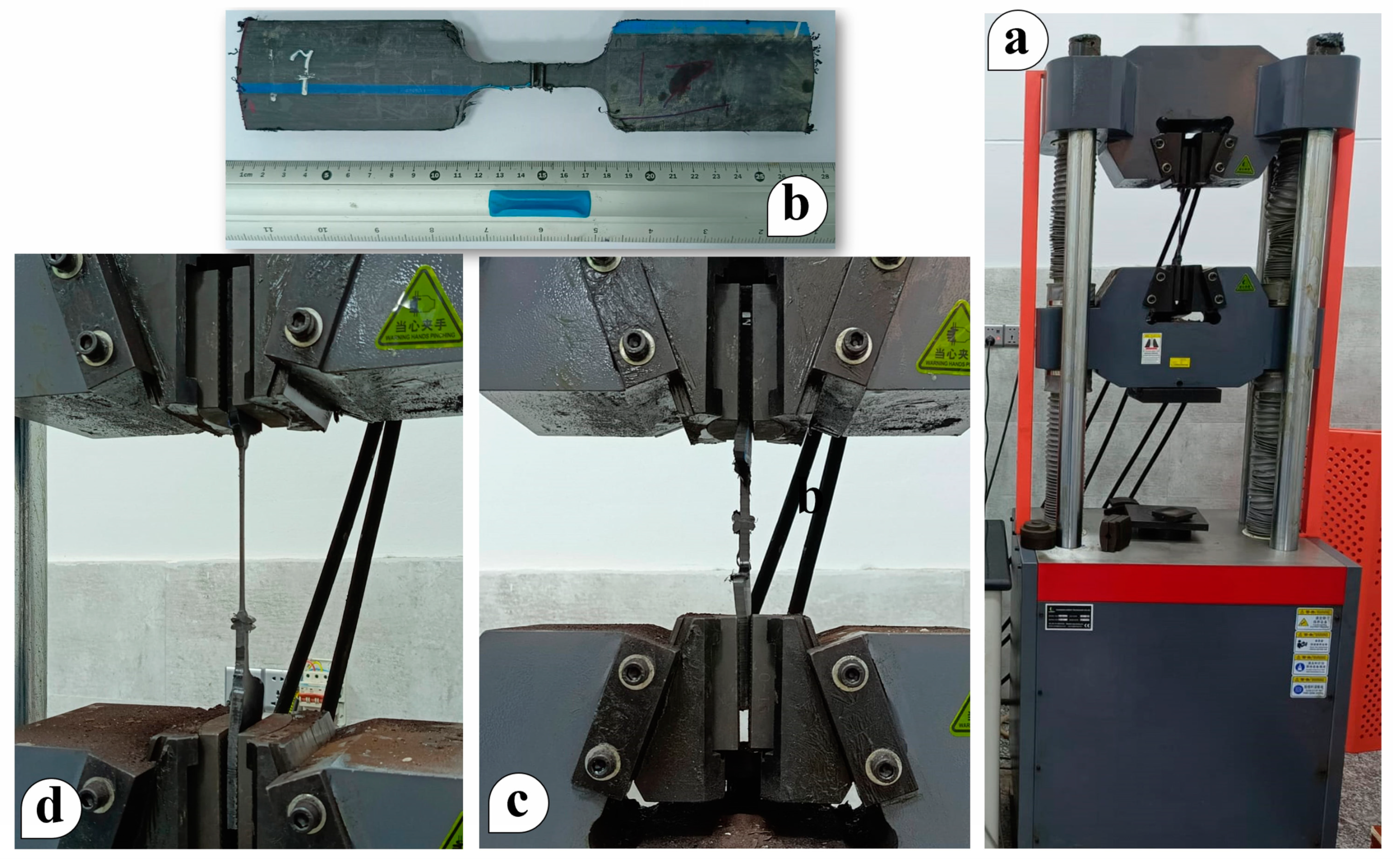
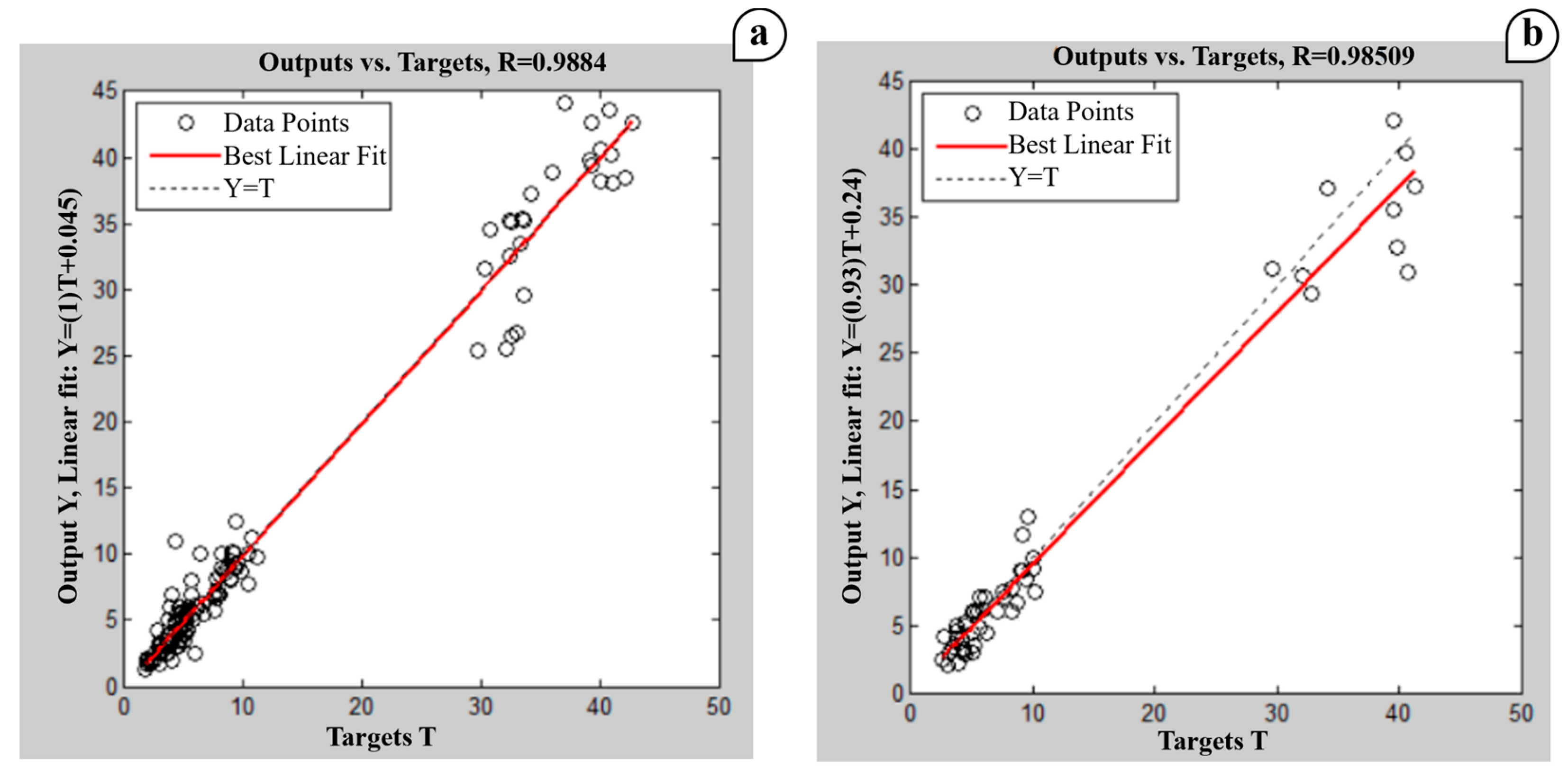
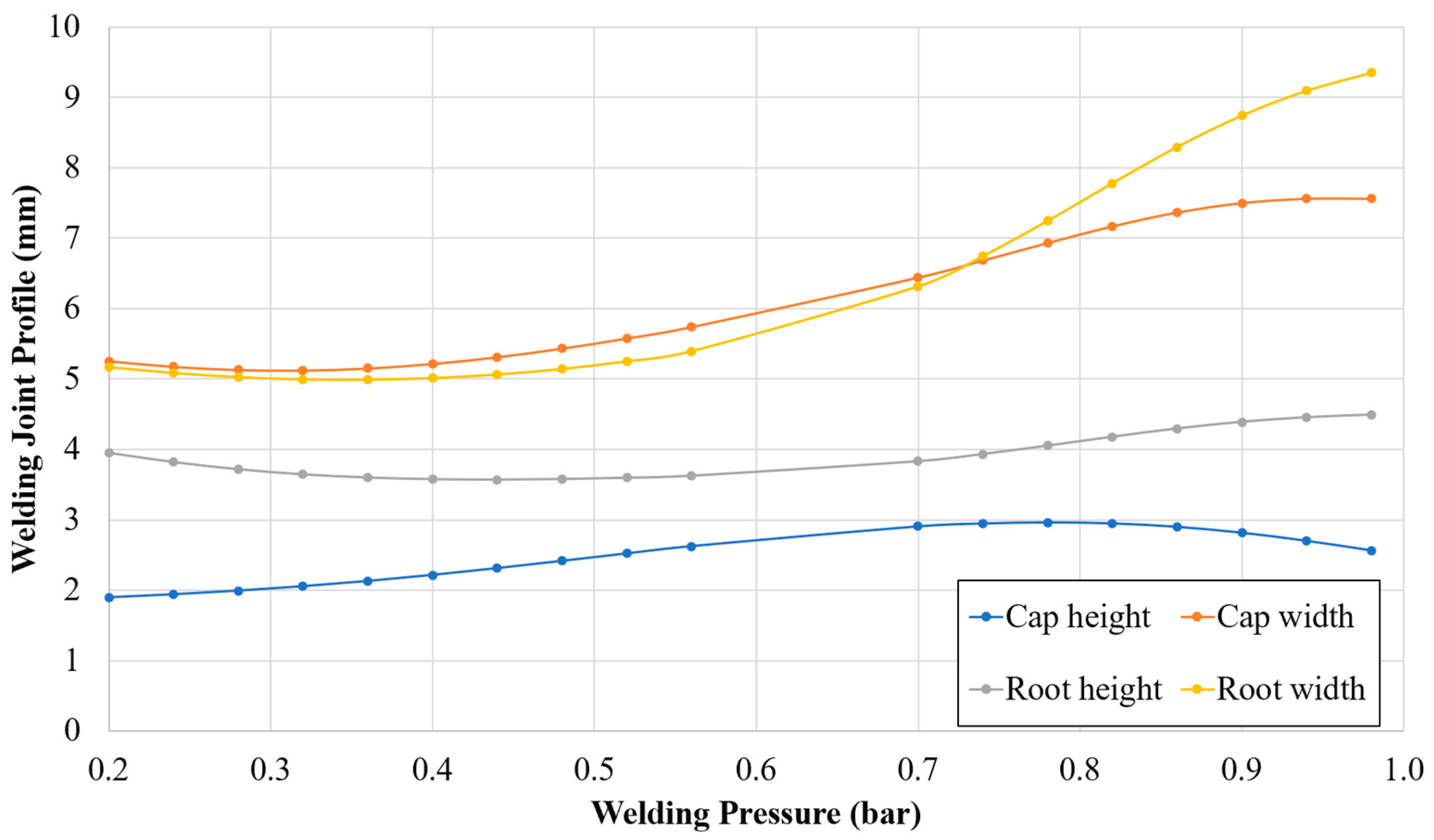
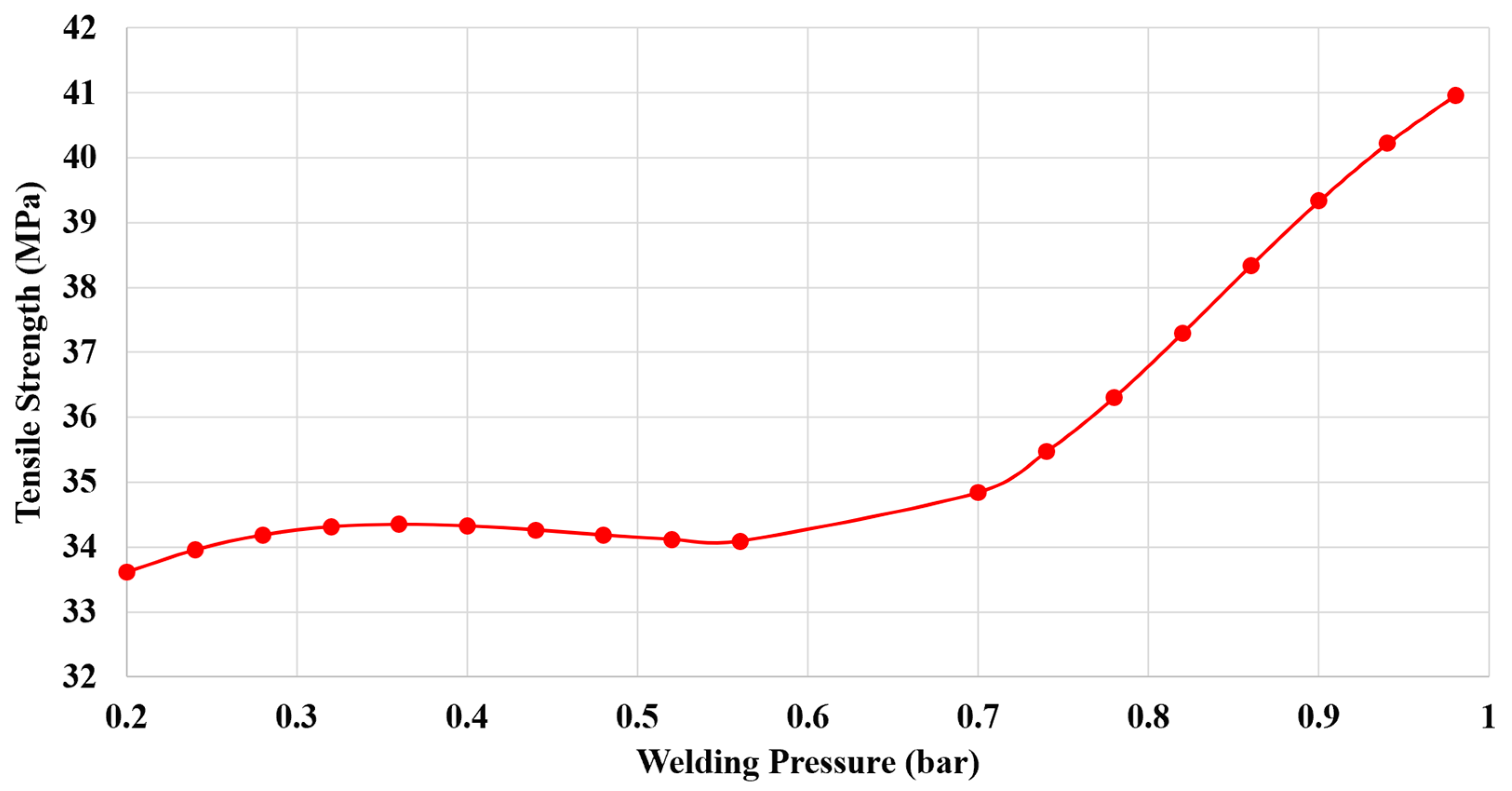
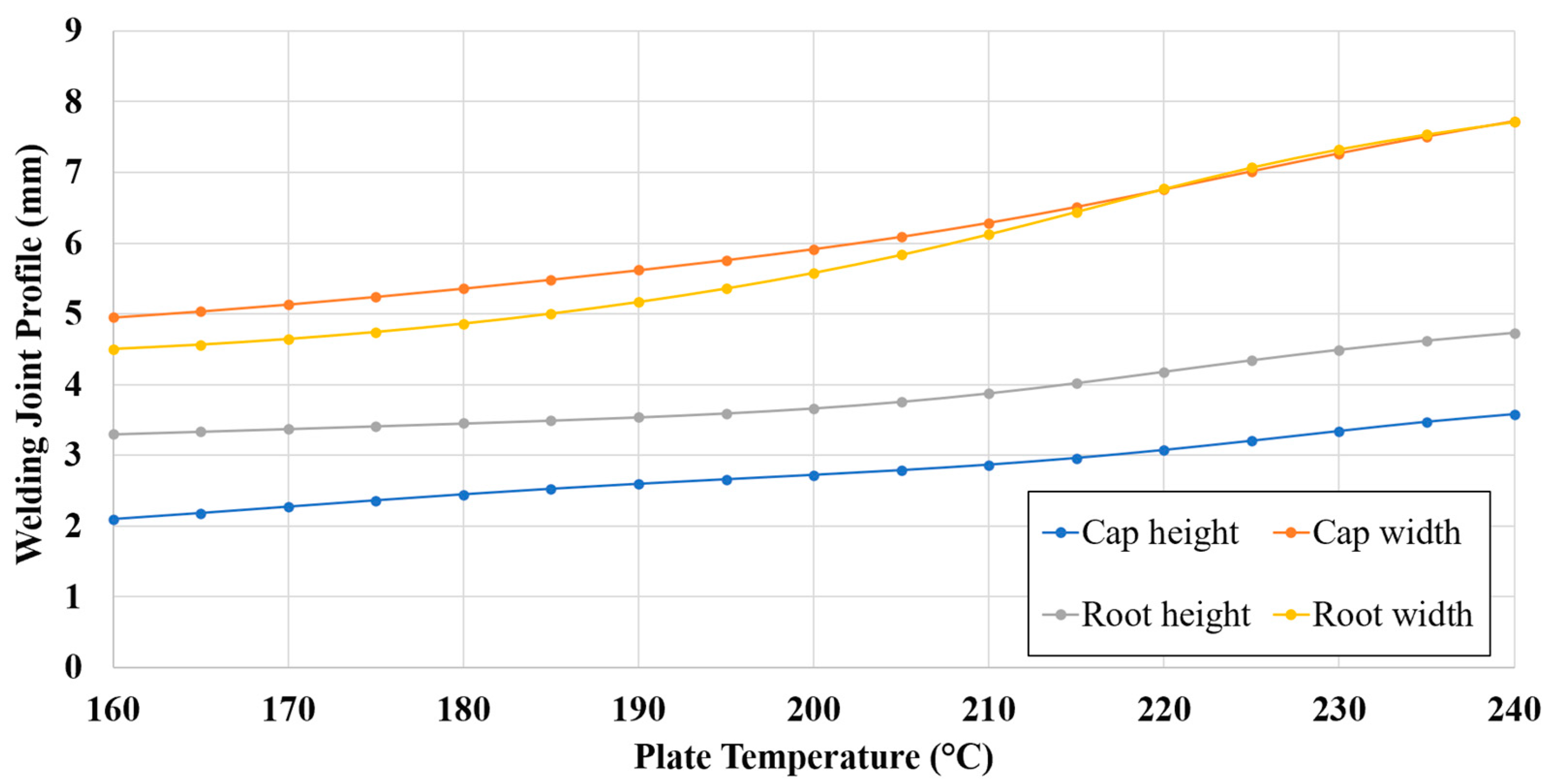
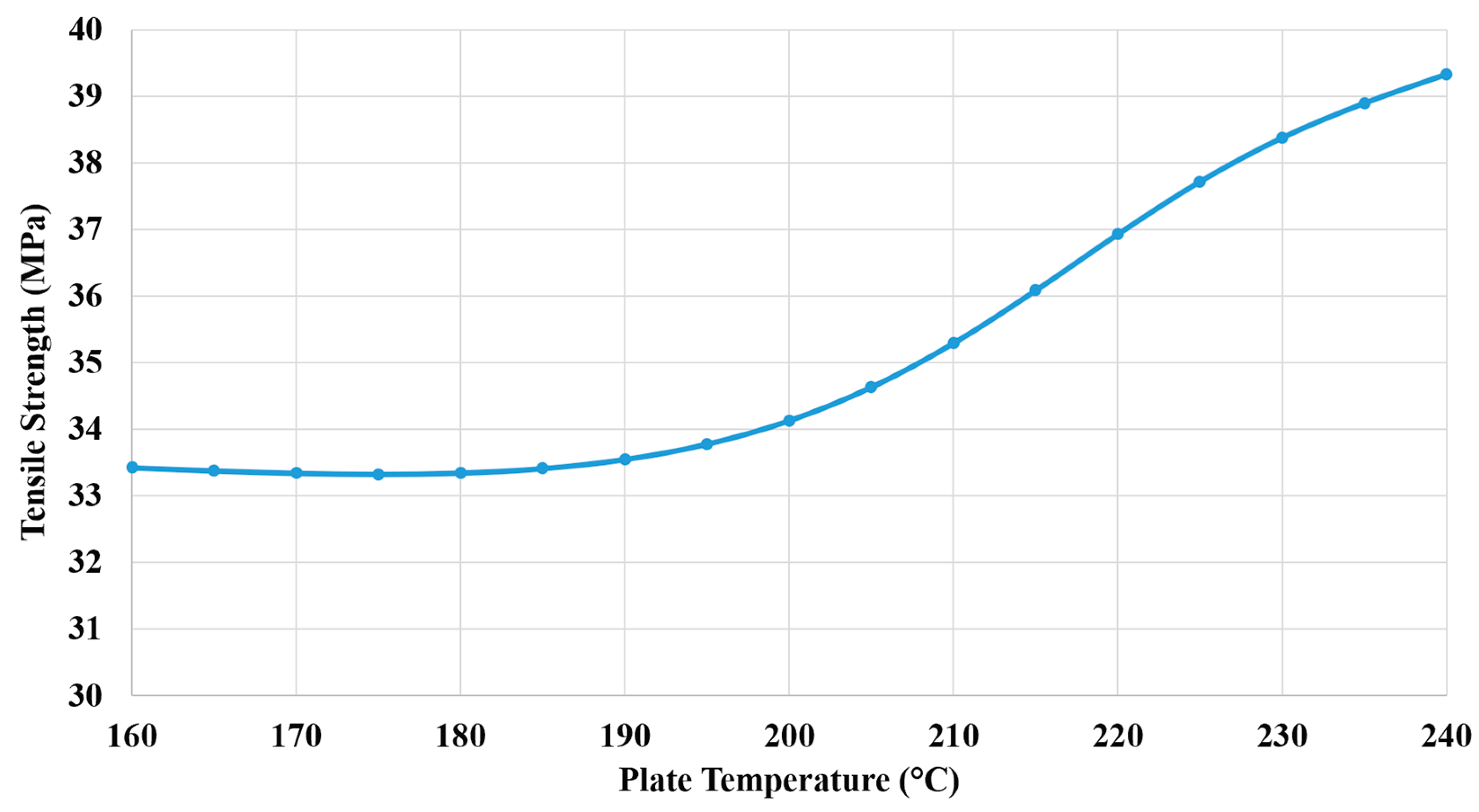
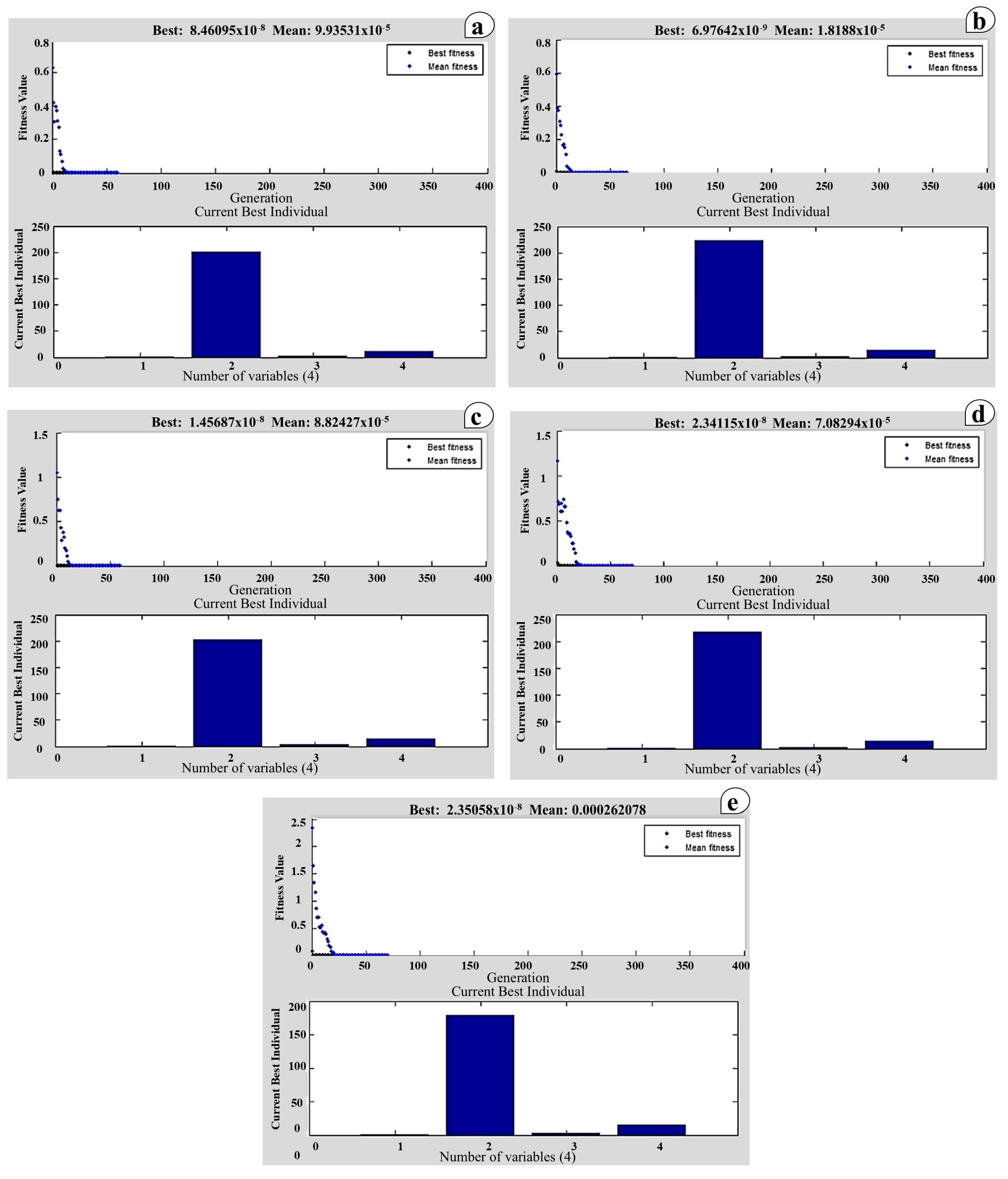
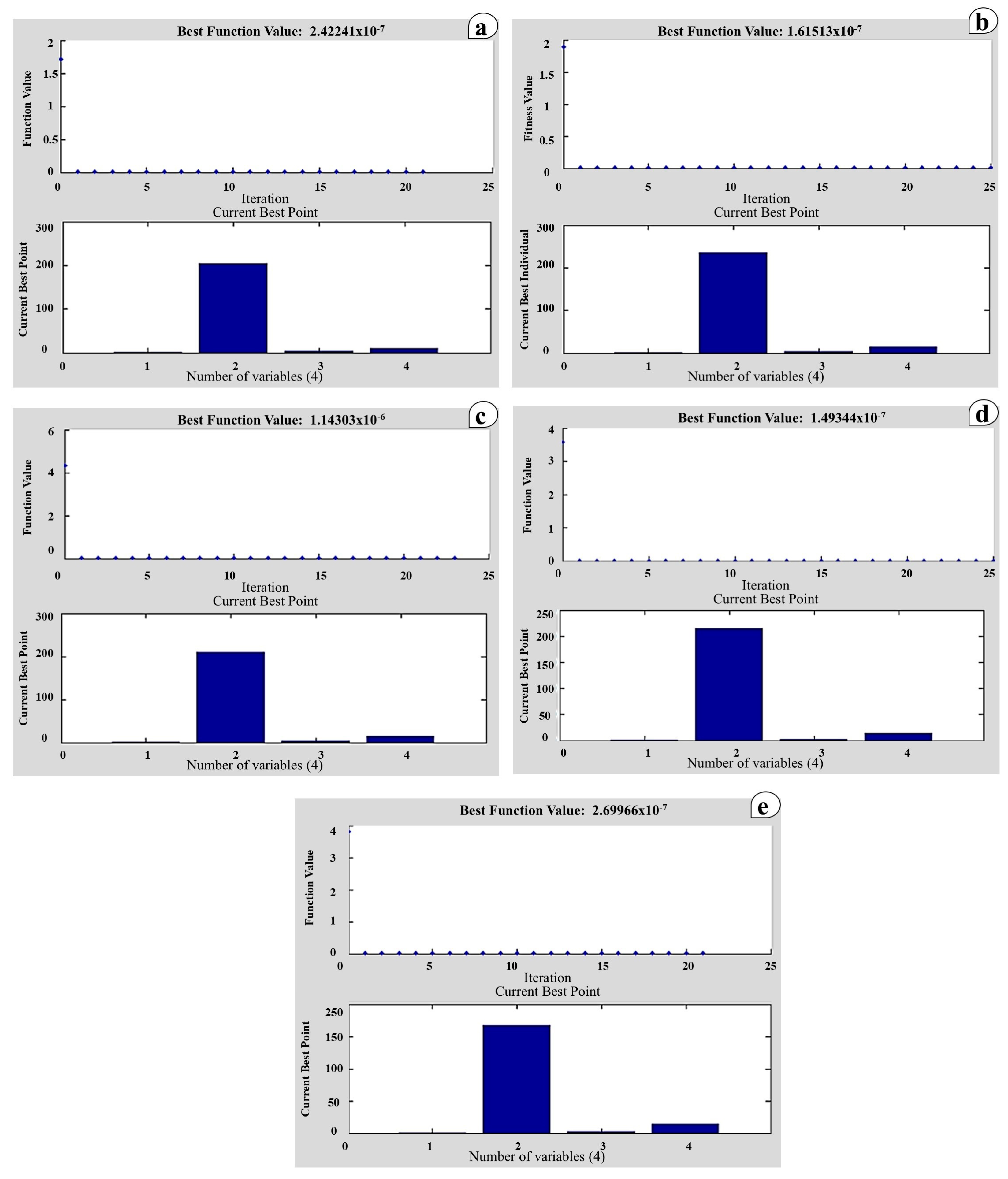
| Input Parameters | Unit | Code Level Value | ||
|---|---|---|---|---|
| −1 | 0 | 1 | ||
| Welding Pressure | Bar | 0.2 | 0.6 | 1 |
| Heater Temperature | °C | 160 | 200 | 240 |
| Soaking Time | Minute | 2 | 6 | |
| Cooling Time | Minute | 10 | 15 | |
| Run | P (bar) | T (°C) | ST (min) | CT (min) | Cap | Root | Tensile Stress (MPa) | ||
|---|---|---|---|---|---|---|---|---|---|
| Height (mm) | Width (mm) | Height (mm) | Width (mm) | ||||||
| 1 | 0.2 | 160 | 2 | 10 | 2.0 | 4.3 | 2.5 | 3.0 | 35.13 |
| 2 | 0.2 | 160 | 2 | 15 | 1.3 | 5.3 | 3.1 | 4.0 | 32.48 |
| 3 | 0.2 | 160 | 6 | 10 | 1.8 | 5.6 | 3.3 | 5.0 | 26.75 |
| 4 | 0.2 | 160 | 6 | 15 | 2.2 | 6.0 | 4.0 | 5.2 | 31.23 |
| 5 | 0.2 | 200 | 2 | 10 | 2.1 | 5.7 | 3.5 | 5.2 | 29.54 |
| 6 | 0.2 | 200 | 2 | 15 | 6.0 | 10.0 | 4.0 | 11.0 | 34.59 |
| 7 | 0.2 | 200 | 6 | 10 | 3.0 | 7.0 | 4.4 | 7.0 | 29.46 |
| 8 | 0.2 | 200 | 6 | 15 | 2.0 | 8.4 | 4.9 | 5.7 | 35.21 |
| 9 | 0.2 | 240 | 2 | 10 | 2.6 | 6.0 | 3.2 | 5.0 | 30.58 |
| 10 | 0.2 | 240 | 2 | 15 | 2.5 | 5.4 | 4.0 | 5.6 | 26.43 |
| 11 | 0.2 | 240 | 6 | 10 | 3.2 | 8.2 | 6.7 | 9.8 | 25.42 |
| 12 | 0.2 | 240 | 6 | 15 | 4.0 | 11.6 | 6.0 | 7.5 | 35.65 |
| 13 | 0.6 | 160 | 2 | 10 | 1.7 | 4.0 | 3.0 | 3.5 | 35.42 |
| 14 | 0.6 | 160 | 2 | 15 | 1.7 | 4.0 | 1.7 | 3.4 | 35.18 |
| 15 | 0.6 | 160 | 6 | 10 | 2.0 | 6.0 | 7.0 | 2.5 | 44.18 |
| 16 | 0.6 | 160 | 6 | 15 | 2.6 | 7.0 | 2.5 | 7.0 | 31.56 |
| 17 | 0.6 | 200 | 2 | 10 | 4.2 | 6.1 | 5.0 | 7.0 | 37.23 |
| 18 | 0.6 | 200 | 2 | 15 | 3.0 | 5.0 | 3.4 | 4.4 | 33.45 |
| 19 | 0.6 | 200 | 6 | 10 | 3.2 | 9.2 | 4.8 | 6.0 | 32.87 |
| 20 | 0.6 | 200 | 6 | 15 | 4.6 | 10.0 | 4.8 | 8.7 | 38.17 |
| 21 | 0.6 | 240 | 2 | 10 | 2.5 | 8.1 | 4.3 | 7.2 | 39.37 |
| 22 | 0.6 | 240 | 2 | 15 | 3.0 | 6.7 | 3.0 | 7.7 | 42.22 |
| 23 | 0.6 | 240 | 6 | 10 | 4.3 | 11.3 | 6.2 | 10.2 | 38.93 |
| 24 | 0.6 | 240 | 6 | 15 | 4.2 | 9.0 | 6.0 | 9.4 | 43.61 |
| 25 | 1 | 160 | 2 | 10 | 2.0 | 5.5 | 2.6 | 6.0 | 25.57 |
| 26 | 1 | 160 | 2 | 15 | 2.0 | 4.4 | 3.4 | 3.5 | 30.77 |
| 27 | 1 | 160 | 6 | 10 | 3.3 | 8.2 | 4.0 | 7.0 | 42.59 |
| 28 | 1 | 160 | 6 | 15 | 2.7 | 8.0 | 3.0 | 7.7 | 42.59 |
| 29 | 1 | 200 | 2 | 10 | 2.4 | 7.5 | 2.8 | 8.3 | 37.36 |
| 30 | 1 | 200 | 2 | 15 | 4.0 | 9.0 | 6.0 | 10.0 | 39.75 |
| 31 | 1 | 200 | 6 | 10 | 6.0 | 10.0 | 8.0 | 9.0 | 40.58 |
| 32 | 1 | 200 | 6 | 15 | 4.5 | 9.0 | 6.0 | 10.0 | 31.03 |
| 33 | 1 | 240 | 2 | 10 | 3.2 | 8.5 | 4.0 | 9.5 | 38.49 |
| 34 | 1 | 240 | 2 | 15 | 4.0 | 8.0 | 4.0 | 9.0 | 38.03 |
| 35 | 1 | 240 | 6 | 10 | 5.0 | 13.0 | 6.0 | 9.0 | 39.75 |
| 36 | 1 | 240 | 6 | 15 | 5.5 | 10.0 | 6.0 | 12.5 | 40.25 |
| Terms | Regression Analysis Equation |
|---|---|
| Cap Height (Ch) | |
| Cap Width (Cw) | |
| Root Height (Rh) | |
| Root Width (Rw) | |
| Tensile Strength (TS) | |
| : welding pressure, : heater temperature, : soaking time, : cooling time. | |
| Source | DF | Joint Cap Height | Joint Cap Width | ||
|---|---|---|---|---|---|
| F-Value | p-Value | F-Value | p-Value | ||
| Regression | 12 | 4.61 | 0.001 | 3.58 | 0.004 |
| P (bar) | 1 | 0.38 | 0.543 | 0.01 | 0.916 |
| T (°C) | 1 | 6.91 | 0.015 | 2.25 | 0.147 |
| ST (min) | 1 | 0.23 | 0.634 | 0.13 | 0.721 |
| CT (min) | 1 | 0.00 | 0.969 | 0.04 | 0.844 |
| P (bar) * P (bar) | 1 | 0.21 | 0.653 | 0.04 | 0.835 |
| T (°C) * T (°C) | 1 | 8.46 | 0.008 | 2.88 | 0.103 |
| P (bar) * T (°C) | 1 | 0.62 | 0.439 | 0.00 | 0.991 |
| P (bar) * ST (min) | 1 | 5.49 | 0.028 | 0.05 | 0.818 |
| P (bar) * CT (min) | 1 | 0.35 | 0.558 | 0.07 | 0.789 |
| T (°C) * ST (min) | 1 | 1.17 | 0.291 | 1.68 | 0.207 |
| T (°C) * CT (min) | 1 | 0.45 | 0.511 | 0.37 | 0.550 |
| ST (min) * CT (min) | 1 | 0.71 | 0.408 | 1.82 | 0.190 |
| Error | 23 | ||||
| Total | 35 | ||||
| Source | DF | Joint Root Height | Joint Root Width | Tensile Strength | |||
|---|---|---|---|---|---|---|---|
| F-Value | p-Value | F-Value | p-Value | F-Value | p-Value | ||
| Regression | 12 | 8.30 | 0.000 | 4.45 | 0.001 | 2.05 | 0.068 |
| P (bar) | 1 | 0.09 | 0.767 | 0.97 | 0.336 | 0.86 | 0.363 |
| T (°C) | 1 | 4.90 | 0.037 | 3.48 | 0.075 | 0.32 | 0.579 |
| ST (min) | 1 | 0.05 | 0.830 | 0.10 | 0.752 | 0.06 | 0.815 |
| CT (min) | 1 | 2.57 | 0.123 | 0.13 | 0.724 | 0.27 | 0.608 |
| P (bar) * P (bar) | 1 | 1.31 | 0.263 | 2.21 | 0.151 | 4.90 | 0.037 |
| T (°C) * T (°C) | 1 | 3.66 | 0.068 | 2.85 | 0.105 | 0.13 | 0.725 |
| P (bar) * T (°C) | 1 | 0.49 | 0.490 | 0.56 | 0.462 | 1.54 | 0.227 |
| P (bar) * ST (min) | 1 | 0.77 | 0.391 | 0.09 | 0.767 | 2.05 | 0.165 |
| P (bar) * CT (min) | 1 | 5.71 | 0.025 | 0.00 | 0.991 | 0.86 | 0.363 |
| T (°C) * ST (min) | 1 | 1.43 | 0.244 | 0.17 | 0.688 | 0.51 | 0.483 |
| T (°C) * CT (min) | 1 | 0.86 | 0.364 | 0.11 | 0.740 | 0.77 | 0.390 |
| ST (min) * CT (min) | 1 | 0.05 | 0.828 | 0.18 | 0.678 | 0.03 | 0.869 |
| Error | 23 | ||||||
| Total | 35 | ||||||
| Outputs | Mean Values | P (bar) | T (°C) | ST (min) | CT (min) |
|---|---|---|---|---|---|
| Cap Height (mm) | 3.5 mm | 0.95 | 201 | 2.1 | 11.5 |
| Cap Width (mm) | 8 mm | 0.93 | 202 | 3.4 | 14.5 |
| Root Height (mm) | 4.5 mm | 0.87 | 224 | 2.48 | 14.1 |
| Root Width (mm) | 7 mm | 0.54 | 218 | 2.33 | 14.2 |
| Tensile Strength (MPa) | 35 MPa | 0.45 | 179 | 2.6 | 14.5 |
| Parameters | Function |
|---|---|
| Poll Method | GPS positive basis 2 N |
| Complete Poll | Off |
| Polling Order | Consecutive |
| Mesh Size | 1 |
| Expansion Factor | 2 |
| Contraction Factor | 0.5 |
| Outputs | Mean Values | P (bar) | T (°C) | ST (min) | CT (min) |
|---|---|---|---|---|---|
| Cap Height (mm) | 3.5 mm | 0.933 | 204 | 2.24 | 10.5 |
| Cap Width (mm) | 8 mm | 0.65 | 199 | 4.3 | 13.2 |
| Root Height (mm) | 4.5 mm | 0.911 | 235 | 2.58 | 14.23 |
| Root Width (mm) | 7 mm | 0.483 | 215 | 2.9 | 13.5 |
| Tensile Strength (MPa) | 35 MPa | 0.45 | 167 | 2.74 | 14.6 |
| Parameters | Method | Mean Values | P (bar) | T (°C) | ST (min) | CT (min) | Best Value |
|---|---|---|---|---|---|---|---|
| Cap Height (mm) | GA | 3.5 mm | 0.95 | 201 | 2.1 | 11.5 | 3.4859 mm |
| PS | 0.933 | 204 | 2.24 | 10.5 | 3.4978 mm | ||
| Cap Width (mm) | GA | 8 mm | 0.93 | 202 | 3.4 | 14.5 | 7.9831 mm |
| PS | 0.906 | 210.7 | 3.02 | 13.95 | 8.0026 mm | ||
| Root Height (mm) | GA | 4.5 mm | 0.87 | 224 | 2.48 | 14.1 | 4.4954 mm |
| PS | 0.911 | 235 | 2.58 | 14.23 | 4.4989 mm | ||
| Root Width (mm) | GA | 7 mm | 0.54 | 218 | 2.33 | 14.2 | 6.9822 mm |
| PS | 0.483 | 215 | 2.9 | 13.5 | 6.9852 mm | ||
| Tensile Strength (MPa) | GA | 35 MPa | 0.45 | 179 | 2.6 | 14.5 | 35.2044 MPa |
| PS | 0.45 | 167 | 2.74 | 14.6 | 34.9975 MPa |
Disclaimer/Publisher’s Note: The statements, opinions and data contained in all publications are solely those of the individual author(s) and contributor(s) and not of MDPI and/or the editor(s). MDPI and/or the editor(s) disclaim responsibility for any injury to people or property resulting from any ideas, methods, instructions or products referred to in the content. |
© 2024 by the authors. Licensee MDPI, Basel, Switzerland. This article is an open access article distributed under the terms and conditions of the Creative Commons Attribution (CC BY) license (https://creativecommons.org/licenses/by/4.0/).
Share and Cite
Mathkoor, M.S.; Jassim, R.J.; Al-Sabur, R. Application of Pattern Search and Genetic Algorithms to Optimize HDPE Pipe Joint Profiles and Strength in the Butt Fusion Welding Process. J. Manuf. Mater. Process. 2024, 8, 187. https://doi.org/10.3390/jmmp8050187
Mathkoor MS, Jassim RJ, Al-Sabur R. Application of Pattern Search and Genetic Algorithms to Optimize HDPE Pipe Joint Profiles and Strength in the Butt Fusion Welding Process. Journal of Manufacturing and Materials Processing. 2024; 8(5):187. https://doi.org/10.3390/jmmp8050187
Chicago/Turabian StyleMathkoor, Mahdi Saleh, Raad Jamal Jassim, and Raheem Al-Sabur. 2024. "Application of Pattern Search and Genetic Algorithms to Optimize HDPE Pipe Joint Profiles and Strength in the Butt Fusion Welding Process" Journal of Manufacturing and Materials Processing 8, no. 5: 187. https://doi.org/10.3390/jmmp8050187






